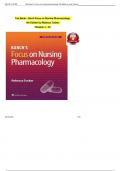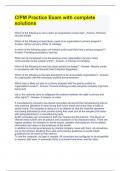Exam (elaborations)
Test Bank for Focus on Nursing Pharmacology 9th Edition by Amy Karch | 9781975180409 | Chapter 1-60 | All Chapters with Answers and Rationals
Test Bank for Focus on Nursing Pharmacology 9th Edition by Amy Karch | 9781975180409 | Chapter 1-60 | All Chapters with Answers and Rationals
[Show more]




